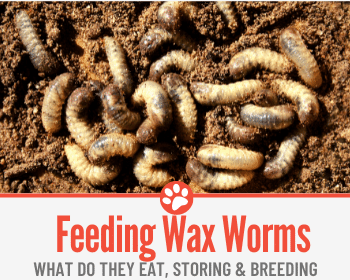 Wax worms can be a good addition to lizard diets, as they are high in calcium, protein and fat.
Wax worms can be a good addition to lizard diets, as they are high in calcium, protein and fat.
But how do you keep the wax worm grub alive, so that you can feed it to your lizard as and when it’s needed?
In this article, we will go over what do Wax Worms eat and how to keep them alive for as long as possible.
What do Wax Worms Eat?
Waxworms in the wild favour a diet of grains, like bran, wheatgerm and oatmeal, but they particularly like honey. The link to the honey is actually where they get their name from. Wax worms treat bee hives as bottomless buffets. Beekeepers view them as pests, because they take up a parasitic existence, eating cocoons, pollen, shed skin from the bees and even chewing through the beeswax.
In captivity wax worms eat a similar selection of foods, but may go long stretches without eating anything at all, especially if they are kept in cool temperatures.
As I did my research I found out that even humans eat wax worms. And, did you know that these are worms that eat plastic too?! There was a lot more to these little benign creatures than I previously had assumed.
A bit more about what wax worms eat
The reason beekeepers hold a special place in Hell for these worms is that for wax worms to reach adult stage, they must eat brood comb or brood cell cleanings to get hold of the protein needed for development at their larval stage. Honey combs are destroyed through their actions, resulting in spilt honey, killing bee larvae and spreading honey bee diseases. Good reasons to make the beekeeper (and bees!) angry.
And what do wax worms drink? That was another question I had. Mix sugar with a little water and that gives them enough to stay hydrated in captivity. In the wild they have access to moisture in the surrounding environment.
But what actually are wax worms
Wax worms are the larva of the wax moth. It has 13 segments (the head, three thoracic segments and nine abdominal segments) and six legs. It also has four pairs of leg-like structures called prolegs – one pair each on abdominal segments three, four, five and six. The prolegs have muscular pads called claspers, which help the larvae hold onto surfaces. The tail (the 13th segment) also has a clasper.
The body is covered with stiff hairs called bristles. You might also notice a row of clearly visible openings called spiracles along each side of the body. The larvae have no lungs and so oxygen enters through the spiracles, and is distributed throughout the body via the fluids inside.
Are wax worms and mealworms the same?
Wax worms and mealworms are not the same animal.
Wax worms are softer, so you need to be a little gentler in handling them. They are white to tan in colour, plump, about 15 to 20mm long and have a segmented body. You’ll find they are moderately active, and like all moths, wax worms make silk. If any of your worms are black in colour, well I’m sorry to say, but those ones are dead.
Mealworms, however, are the larvae of the worm beetle. At 25mm, they are a little longer. Otherwise, they are fairly similar in that they also eat grains, can be eaten by both humans and animals, and are also considered as pests by some.
It’s also worth noting that wax worms are not the same as maggots. Maggots are the larvae of a fly and are typically found on decaying matter.
Should you refrigerate wax worms
I keep some of my reptile’s food in the chiller, but should you refrigerate wax worms? It turns out, that you don’t have to but yes, you can. Storing the worms at 55oF means you’ll have them for a couple of weeks, so find a spot in a cool, dark, well ventilated area and hide them away there. The door of your fridge is a little cooler, but that is still fine. Keep them at room temperature and they will pupate into moths within a couple of days.
How to breed wax worms
Breeding wax worms is fairly easy. If you want to keep the worms for a reasonable length of time, store them at cool temperatures, with a regular supply of grains, honey or sugared water. If you want to breed them into moths, raise their environmental temperature to around 82–93°F and see them pupate in as little as 6 weeks. They follow a cycle of gorging on food as a larva, then quickly (within about a week) transforming into pupae. The rest of the time in the cocoon is spent developing into a moth, and finally the adult appears.
Once a few adult moths appear, transfer them into an empty 2-liter glass container to let them mate and lay eggs. The moths are inactive early in the day, so it is best to move them in the morning. Cover the jar with a ventilated lid, secured in place to avoid accidentally knocking the lid off. If you empty the jar and plan to use it for a further generation of moths, make sure to clean it out well before use.
What are wax worms used for
They are grown to use as feed for reptiles or insectivorous birds, but are also eaten by humans. High in protein, they make a good substitute to other food sources. Be careful though, their high fat content means our scaly friends should eat them in moderation, but they are good to fatten up any under-weight lizard or reptile.
Typically, they are given to bearded dragons, the neon tree dragon, geckos, brown anole, turtles and chameleons. Amphibians, such as Ceratophrys frogs, newts, the Strauch’s spotted newt and salamanders, like axolotls, also enjoy them. Small mammals like a hedgehog would also eat them, as would some birds. Even some captive predatory insects, reared in terrarium, would devour a wax worm.
Wax worms have also been used in medical research, exploring the virulence mechanisms of bacterial and fungal pathogens. Incredibly, their innate immune system is similar to that of humans and so make viable candidates for certain scientific trials.
Related Questions
Do wax worms eat plastic
Wax worms have been called the ‘plastic eating worms’ and the fact that they eat plastic is not a complete myth. Certain strains can digest polyethylene, converting it into ethylene glycol, which is easily biodegradable. It’s not actually the worms that degrade the plastic, but two strains of bacteria, found in their gut. Enterobacter asburiae and Bacillus sp have a happy symbiotic relationship with the worms and make eating unusual compounds like plastic look like a baby munching through porridge.
The process is fairly slow though, and 100 wax worms take about 12 hours to digest only 0.1g of plastic – that is about a month for the whole bag. You won’t save the planet quickly in this way.
Can wax worms bite
No. These soft, squidgy grubs won’t do you any harm.
Can I use wax worms as bait
Yes, that is possible. Many anglers have a nickname for these white creatures, calling them “waxies”. They are favoured when fishing for certain species, such as panfish, sunfish, green sunfish, the Salmonidae family, Masu salmon, white-spotted char and rainbow trout. Wax worms are also used in shallow water fishing with a lighter weight.
Where can you buy them
Nowadays you can buy anything and everything online. Amazon and online pet stores will be able to mail you some through the post. If you prefer going into bricks and mortar, head to a fishing shop or even your usual pet store; they are sure to be able to help.






